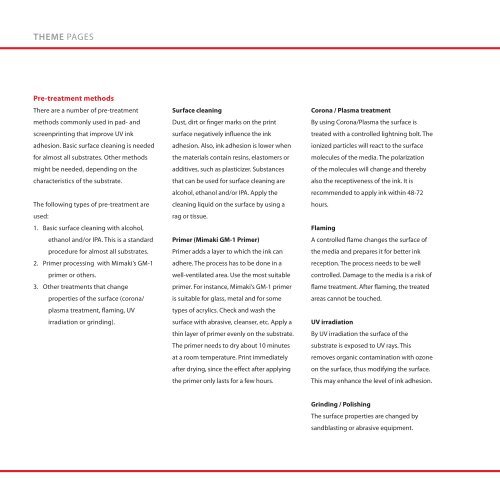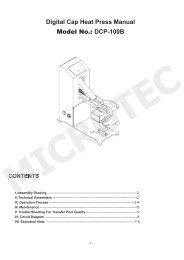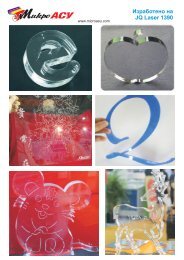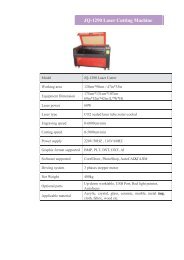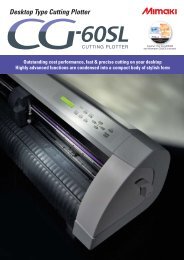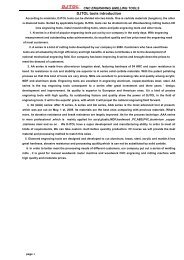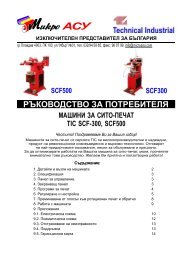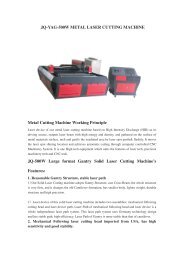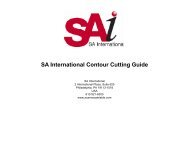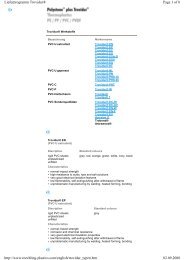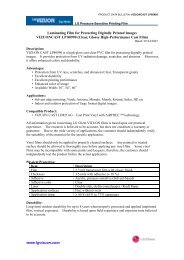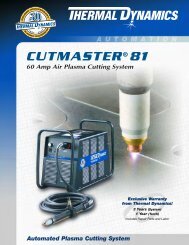Mimaki Guide 2011.pdf - HOME
Mimaki Guide 2011.pdf - HOME
Mimaki Guide 2011.pdf - HOME
Create successful ePaper yourself
Turn your PDF publications into a flip-book with our unique Google optimized e-Paper software.
THEME PAGESTHEME PAGESPre-treatment methodsSubstrate conditionsThere are a number of pre-treatmentSurface cleaningCorona / Plasma treatmentmethods commonly used in pad- andDust, dirt or finger marks on the printBy using Corona/Plasma the surface isThe adhesion of UV ink varies according to the substrate:screenprinting that improve UV inksurface negatively influence the inktreated with a controlled lightning bolt. Theadhesion. Basic surface cleaning is neededadhesion. Also, ink adhesion is lower whenionized particles will react to the surfaceUsually good adhesion after surface cleaning: - ABS - PVCfor almost all substrates. Other methodsthe materials contain resins, elastomers ormolecules of the media. The polarizationIn some cases pre-treatment with primer might still be - Polycarbonate - Polystyrenemight be needed, depending on theadditives, such as plasticizer. Substancesof the molecules will change and therebybe necessary. Please test behorehand. - Paper and wood - Composite panelscharacteristics of the substrate.that can be used for surface cleaning arealso the receptiveness of the ink. It isalcohol, ethanol and/or IPA. Apply therecommended to apply ink within 48-72Better adhesion after pre-treatment:- GlassThe following types of pre-treatment arecleaning liquid on the surface by using ahours.e.g. primer or plasma/corona- Metal, Aluminumused:rag or tissue.- Acrylics (not all acrylics)1. Basic surface cleaning with alcohol,Flaming- PETethanol and/or IPA. This is a standardPrimer (<strong>Mimaki</strong> GM-1 Primer)A controlled flame changes the surface ofprocedure for almost all substrates.Primer adds a layer to which the ink canthe media and prepares it for better inkGood adhesion difficult to achieve:- PP (Polypropylene) resin and PE (Polyethylene)resin2. Primer processing with <strong>Mimaki</strong>’s GM-1adhere. The process has to be done in areception. The process needs to be wellCertain pre-treatment methods may improve adhesion.- Silicone resinprimer or others.well-ventilated area. Use the most suitablecontrolled. Damage to the media is a risk of- Painted a nd UV coated surfaces3. Other treatments that changeprimer. For instance, <strong>Mimaki</strong>‘s GM-1 primerflame treatment. After flaming, the treated- Copper and brassproperties of the surface (corona/is suitable for glass, metal and for someareas cannot be touched.plasma treatment, flaming, UVtypes of acrylics. Check and wash theThis adhesion evaluation does not guarantee performance. Please test beforehand.irradiation or grinding).surface with abrasive, cleanser, etc. Apply aUV irradiationthin layer of primer evenly on the substrate.By UV irradiation the surface of theMore information about substrate conditions and substrate/application examples can be foundThe primer needs to dry about 10 minutessubstrate is exposed to UV rays. Thisin the presentation: “How to improve UV ink adhesion”, which has been sent to resellers.at a room temperature. Print immediatelyremoves organic contamination with ozonePlease contact your sales representative if you would like to receive this presentation.after drying, since the effect after applyingon the surface, thus modifying the surface.the primer only lasts for a few hours.This may enhance the level of ink adhesion.Grinding / PolishingThe surface properties are changed bysandblasting or abrasive equipment.


